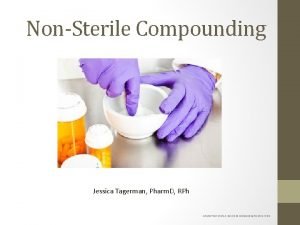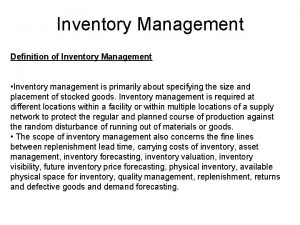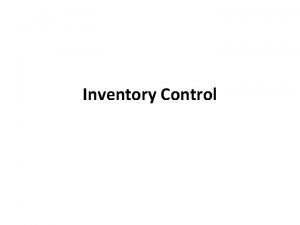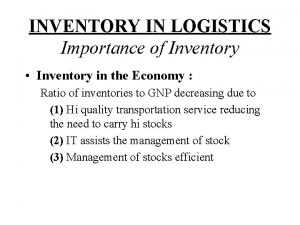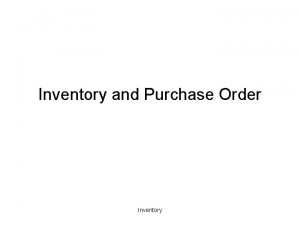Inventory Management JESSICA TAGERMAN PHARMD RPH Adapted from
















- Slides: 16

Inventory Management JESSICA TAGERMAN, PHARMD, RPH Adapted from Pharmacy Technician Quick Study Guide & Mosby’s Review for the Pharmacy Technician Certification Exam

What is Inventory Management? Why is it important?

What is inventory management? • Inventory • Products or merchandise (e. g. drugs, devices) available to meet future demand • 2 Main Goals of Inventory Management: • Ensure medication is available to patients when they need it • Ensure costs associated with product procurement/time spent on inventory management are minimal.

Ordering Inventory • Ordering procedures are different for each pharmacy. • Factors that influence product ordering decisions: • Inventory turnover rate • Manufacturing sources • Purchase price

What are some strategies used to manage inventory?

Inventory Management Strategies • Just-in-time ordering: • Ordering a product just before it’s used. • PAR (Periodic automatic replacement) Value • Drug that is automatically reordered based on minimum and maximum inventory levels. • ABC Analysis: • A method used to identify and define inventory items based on their usage. • Focuses efforts based on the products that will have the greatest inventory turnover rate

Inventory Management Definitions • 80/20 Rule: • 80% of a pharmacy’s drug costs are derived from 20% of the pharmaceuticals carried. • Focuses on inventory control of the top 20% of the items carried. • Inventory turnover rate: • The cost of goods sold over the average inventory value • The larger the # of inventory turns indicates better utilization of financial resources of an institution

What are the types of different suppliers a pharmacy can use for the acquisition of medication?

Suppliers • Wholesale drug distributors • Stock medications from all manufacturers • Manufacturers • Allows pharmacies to purchase in bulk, resulting in a savings for the company • Other pharmacies

Receiving Inventory • Upon delivery, a technician must verify accuracy of the received order with the original purchase order and the packing slip. • Drug name and manufacturer • Strength and dosage form of the medication • Appropriateness of packaging type • Quantity • Number of units received vs. number ordered • Damaged inventory • Should always document incorrect products or product shortages • Controlled substances require additional documentation

Storing Inventory • Technicians must learn which products require special storage conditions (i. e. refrigeration) Temperature Definitions °C °F Room Temperature Between 20° and 25° Between 68° and 77° Refrigeration Between 2°and 8° Between 36° and 46 ° Freezing Between -25° and -10° Between -13° and -14° • Stock rotation procedures are VERY important! • Items that expire soonest should be placed in the front.

What are the different types of inventory counts?

Types of Inventory Counts • Initial • Accurate inventory of all controlled substances taken before a new pharmacy opens or when there is a change in PIC • Biennial: • Inventory required by DEA of all controlled substances every 2 years • CII- must be exact, CIII-CV, may be estimated • Perpetual: • Inventory that reflects exactly what is on hand at a particular time • Most commonly performed on CII medications • Physical: • An inventory conducted on a basis (typically yearly) to determine exactly what is on hand at a particular moment in time and the value of the inventory based on the current cost of that item

Medication Disposition • Recalls • Can be initiated by the manufacturer or the FDA • Class I- reasonable probability that use or exposure will cause serious consequences or death • Class II- use or exposure may cause temporary or reversible adverse consequences, with a remote possibility of serious consequences • Class III – use or exposure is not likely to cause adverse consequences • Expired medications • In many cases, pharmacies return expired, discontinued, recalled, or unusable products to the seller, and get a partial credit on return • Some medications cannot be returned- need to dispose of in accordance with federal and state laws and regulations. • Each pharmacy’s policy/procedures regarding expired medication is different

FDA Approved: How the FDA approval process works Whiteboard discussion!!

Financial Accounting Terminology Be sure to learn & familiarize yourself with the terms listed on pages 196 -197 of Mosby’s Review for the Pharmacy Technician Certification Exam!
 Elizabeth farrington pharmd
Elizabeth farrington pharmd Ernest mario
Ernest mario This passage is adapted from jane austen
This passage is adapted from jane austen How are red blood cells adapted
How are red blood cells adapted Adapted with permission from
Adapted with permission from In what ways have the highland maya adapted to modern life?
In what ways have the highland maya adapted to modern life? How are plants adapted for gas exchange
How are plants adapted for gas exchange Chaparral biome animals
Chaparral biome animals How is a camel adapted to life in a desert
How is a camel adapted to life in a desert Sausage shaped organelles
Sausage shaped organelles Brother quotes from brother
Brother quotes from brother Adapted from the internet
Adapted from the internet How is amoeba adapted for gas exchange bbc bitesize
How is amoeba adapted for gas exchange bbc bitesize How have plants adapted to the rainforest
How have plants adapted to the rainforest Spermopsida
Spermopsida The outsiders adapted for struggling readers
The outsiders adapted for struggling readers Number synoynm
Number synoynm

















